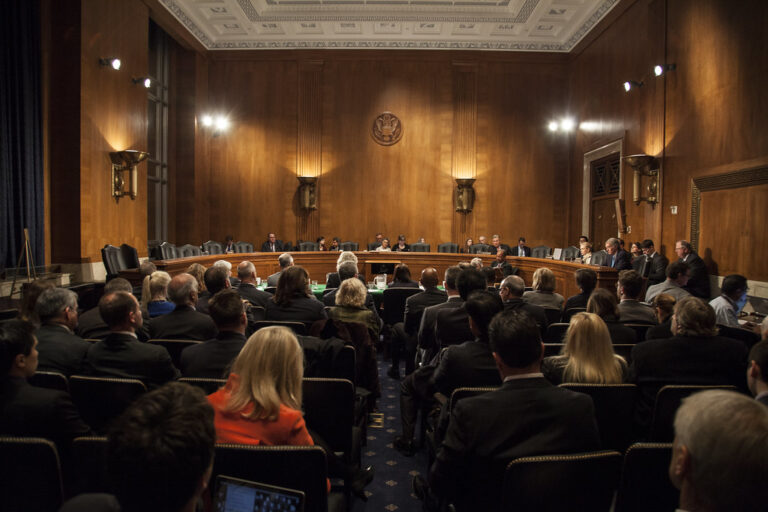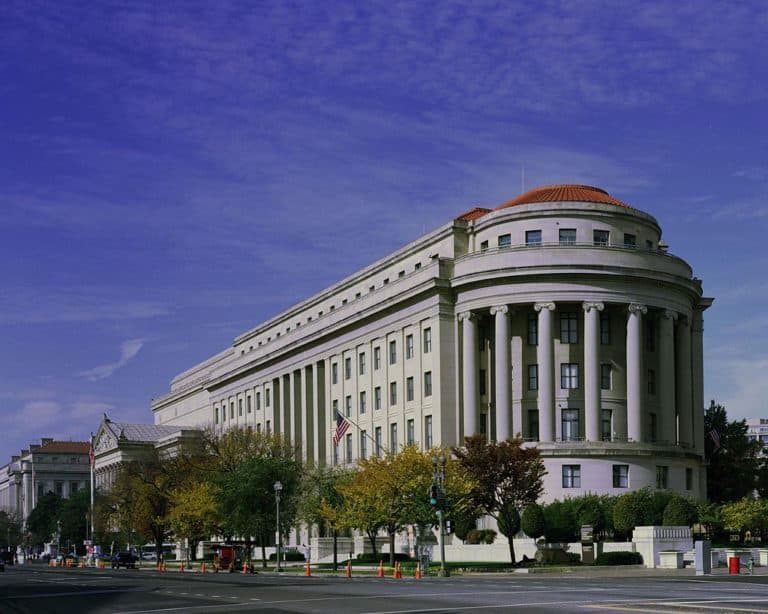David Rolf has led some of the largest union organizing campaigns since the 1940s. He is President of SEIU 775, The Workers Lab, Working Washington, and the Fair Work Center; International Vice President of SEIU; and the author of “The Fight for Fifteen” (New Press, 2016). Views expressed here are his own.
This post is part of a series on Labor in the Trump Years.
If one were able to magically scrub the embedded racism, misogyny and xenophobia from Donald Trump’s slogan “Make America Great Again,” one might conjure up an image of unionized America circa 1946-1976: high wages, high employment, stable jobs, good benefits; expanding investments in infrastructure, education, and home ownership; a growing economy that lifted all boats and created more middle class wealth than in any era before or since. “Solidarity Forever,” we would sing, to the tune of the Battle Hymn of the Republic, “for the Union makes us strong.”
But although Donald Trump spent precious few words on labor law and labor policy during his campaign, it’s fair to expect that single-party Republican control of all three branches of the federal government will bring only bad news for America’s already-fading unions.
Between now and at least 2021, the best scenario that union leaders can reasonably hope for from the Federal government includes hostile appointments to the NLRB, the DOL, and the judiciary; a rolling-back of progressive Obama-era efforts to modernize both NLRB election procedure and DOL overtime rules; the use of regulation, budget-writing, procurement, and other government powers to chip away around the edges of prevailing wages, wage and hour protections, workplace safety, and nondiscrimination; total or partial repeal of Obamacare; and some short-term job creation if the President-elect is successful in passing an infrastructure package and renegotiating trade agreements on more favorable terms (and assuming he is simultaneously unsuccessful in deporting 11 million wage-earners and triggering a depression by doing so).
A worse but equally likely scenario is a continued and concerted national campaign to weaken and shrink unions themselves. More right to work laws. The return of Friedrichs and its ilk. Continued assaults on public employee unions in the two-thirds of state houses controlled by conservatives. And legal challenges to the notion of exclusive representation itself, brought by adherents of previously obscure and cultish legal theories.
A handful of union leaders in the construction, carbon emissions, and law enforcement sectors may choose to align themselves with the incoming administration in hopes of harvesting a few favors or a few jobs for union members.
A far greater number of union leaders will justifiably and eloquently rail against the new order and pledge renewed collaboration with progressive allies, but with increasingly small and besieged audiences of union members left to listen. Wagons will be circled. Drawbridges will be raised. Poorly thought out union mergers will be negotiated and inked, primarily to protect union staff and officers from declining budgets. We will once again be called to stand with mainly uninspiring Democrats (and a few inspiring ones) in the 2018 and 2020 elections, each of which we will call “the most important election of our lifetime.” Meanwhile our numbers will continue to shrink and our power continue to wane.
If necessity is the mother of invention, now would be the right time for America’s unions to run straight to their laboratories, workshops, incubators, and research hubs to figure out a new model of worker power for the new century. The right time to transfer resources, assets, and talent to exciting new start-up worker organizations that show promise for building powerful, scalable, sustainable new models of worker advocacy. The right time to consult our extensive network of outside experts drawn from the ranks of the world’s most accomplished innovators and most prescient scenario-planners. A great moment to empower the ambitious younger generations within our ranks to take the helm of sclerotic institutions currently led by leaders in their sixties and seventies.
Except, with very few exceptions, there are no such laboratories, no such new organizations, no such experts, and no such younger generation. (According to one scholar of retirement policy I spoke with recently, union staff are the demographically second-oldest profession in America, exceeded only by morticians). Old Labor has not prepared its own succession plan, its own emergency kit, or its own escape pod.
For nearly the entire era of the institutional union movement’s decline, labor leaders have been committed to using the power of the Federal government to bring back the now-failed American system of enterprise-based exclusive representation that Congress assigned to us in 1935. From attempts to repeal the Taft-Hartley Act under President Johnson, to comprehensive labor law reform efforts under President Carter, to proposals to ban permanent striker replacements under President Clinton, to the Employee Free Choice Act under President Obama, union strategy has been to leverage the power of the Federal government to restore institutional labor’s glory days. It hasn’t worked yet.
Economists, behavioral psychologists, and military historians describe the sunk cost or escalation of commitment fallacy as “the phenomenon where people justify increased investment of money, time, lives, etc. in a decision, based on the cumulative prior investment (sunk costs), despite new evidence suggesting that the cost, beginning immediately, of continuing the decision outweighs the expected benefit.”
Perhaps this election could finally put to rest the union movement’s own sunk cost fallacies: the increasingly hallucinatory idea that a future Democratic-controlled Federal government is going to come riding to the rescue of America’s existing unions before it’s too late, or that our resources should continue to be poured into the same enterprise-bargaining-related activities as they have since the 1940’s. Or that the hundreds of millions of dollars the labor movement spent just on Wisconsin gubernatorial elections between 2010 and 2014 couldn’t have been better used to build new forms of worker power.
As nearly everyone outside the institutional labor movement has already known for years, our old unions and our old system of collective bargaining aren’t coming back. The question is, rather, whether it will be replaced by something, or by nothing at all. If unions merely escalate our prior commitments, we will spend hundreds of millions of dollars on defense in the next four years and still not maintain today’s failed status quo: we’ll be weaker then than now.
If we, together with allies, can imagine a massive realignment of resources and strategy, it could be the start of the next workers movement in America.
So instead of spending the next four years repeating old behaviors, putting good money after bad, defending turf we can’t defend, and doubling down on strategies from the last century, we need to figure out a new path forward and resource it accordingly.
The next labor movement won’t consist of unions as we currently know them in the U.S. It won’t be based on contract bargaining at the enterprise level or exclusive representation. It must be based on a value proposition to incentivize voluntary membership (as well as other revenue sources). It must have the power to impact workers lives economically. And it must be able to scale and touch millions of American workers.
The most important single task of today’s remaining unions is to seed innovation and discover powerful, scalable, sustainable new models of worker organization, just as the pioneers of industrial unionism did in the early decades of the last century. At least in the short run, they should be able to exist independent of and indifferent to federal power. These experiments should attempt at least seven specific strategies used by other labor movements globally or historically, or other types of membership organizations, for impact and value: politically constructed (at the state or city level) regional and sectoral bargaining over minimum standards, benefits provision, labor standards enforcement, certification and labeling, workforce training, workforce supply, and advocacy. And they should be prototyped in pro-union cities and states where they have the greatest chances of success and the fewest well-resourced enemies.
Resisting the sunk cost or escalation of commitment fallacy in the age of Trump will require labor unions to act with uncharacteristic discipline and strategic sense. It will require withdrawing resources from failed strategies and failed geographies, which is certain to be unpopular with union members and Democrats alike. And it will require the investment, ultimately, of hundreds of millions of dollars in a search for a new model that isn’t guaranteed to succeed.
Nothing will be more difficult for labor to accomplish. But nothing is more necessary for labor’s future than the birthing of whatever will grow to replace today’s unions.






Daily News & Commentary
Start your day with our roundup of the latest labor developments. See all
November 23
Workers at the Southeastern Pennsylvania Transportation Authority vote to authorize a strike; Washington State legislators consider a bill empowering public employees to bargain over workplace AI implementation; and University of California workers engage in a two-day strike.
November 21
The “Big Three” record labels make a deal with an AI music streaming startup; 30 stores join the now week-old Starbucks Workers United strike; and the Mine Safety and Health Administration draws scrutiny over a recent worker death.
November 20
Law professors file brief in Slaughter; New York appeals court hears arguments about blog post firing; Senate committee delays consideration of NLRB nominee.
November 19
A federal judge blocks the Trump administration’s efforts to cancel the collective bargaining rights of workers at the U.S. Agency for Global Media; Representative Jared Golden secures 218 signatures for a bill that would repeal a Trump administration executive order stripping federal workers of their collective bargaining rights; and Dallas residents sue the City of Dallas in hopes of declaring hundreds of ordinances that ban bias against LGBTQ+ individuals void.
November 18
A federal judge pressed DOJ lawyers to define “illegal” DEI programs; Peco Foods prevails in ERISA challenge over 401(k) forfeitures; D.C. court restores collective bargaining rights for Voice of America workers; Rep. Jared Golden secures House vote on restoring federal workers' union rights.
November 17
Justices receive petition to resolve FLSA circuit split, vaccine religious discrimination plaintiffs lose ground, and NJ sues Amazon over misclassification.